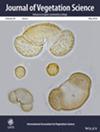Topography and Logging Structure Liana Community Assemblages in an Upland Evergreen Forest, Ghana
Abstract
Aims
Lianas form an important component of tropical forests as they contribute to maintaining biodiversity. Thus, understanding the factors that control them is essential for forest management and biodiversity conservation. However, how topography and logging, as well as their interaction, affect liana community structure is not well understood. Therefore, we sought to evaluate the effects of topography and logging on the structure of liana communities in a tropical upland evergreen forest in Ghana.
Location
Tano Offin Forest Reserve, Ghana.
Methods
We assessed liana community structure by quantifying liana species diversity and composition, abundance, and basal area in nine 20 × 20 m plots, each of three topographic habitats (valley, slope, hilltop) in two land-use types (non-logged and logged-over forests) in the Tano Offin Forest Reserve, Ghana. We measured elevation and slope angle, and quantified host tree abundance and basal area for each plot.
Results
Topographic position influenced liana species diversity, abundance and basal area across the forest land-use types, with the valley habitat supporting a significantly greater values than the other habitats. In the same vein, topographic position was a significant predictor of liana species diversity, abundance and basal area in the logged-over forest, but not the non-logged forest. Selective logging also showed significant negative effects on liana species diversity, abundance and basal area, both across forest land-use types and within slope and hilltop habitats. Similarly, there were significant effects of topographic habitat and logging, and their interaction on liana species composition. Liana species composition was significantly driven by elevation, while liana abundance and basal area were predicted by elevation, slope angle, and tree abundance and basal area.
Conclusion
In view of our findings, forest managers should take into account the heterogeneity of topographic landscapes in their management operations and pay particular attention to areas that support higher plant assemblages, such as valleys. The findings further suggest that logging operations in topographic landscapes should be conducted in a manner that does not disrupt the topographic patterns of plant community structure.


 求助内容:
求助内容: 应助结果提醒方式:
应助结果提醒方式:


